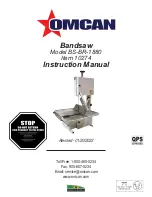
29
Push the reset thermal-overload button on the side of the
ON/OFF switch assembly. Make certain that the saw
blade and work are has been cleared of debris before
restarting saw. The motor can now be turned on again.
T
he
f
o
ll
o
w
ing se
c
tion
wa
s
d
esigne
d
to gi
v
e
instru
c
tions on the b
a
si
c
oper
a
tions o
f
this t
a
b
l
e
s
aw. H
o
w
e
v
er, it is in no
wa
y
c
o
m
prehensi
v
e o
f
e
v
ery t
a
b
l
e s
aw a
pp
l
i
ca
tion
. I
t is strong
l
y
re
c
o
mm
en
d
e
d
th
a
t you re
ad
books, tr
ad
e
ma
g
az
ines,
or get
f
or
mal
tr
a
ining to
max
i
m
i
z
e the potenti
al
o
f
your t
a
b
l
e s
aw a
n
d
to
m
ini
m
i
z
e the risks
.
PRE-RUN CHECK
Before you begin to use your Table Saw, you should
give it a thorough inspection, making sure you ask
yourself the following questions:
1. Is the blade mounted correctly?
2. Is the saw stable?
3. Is it wired properly?
4. Is the electrical system properly configured?
5. Have you checked your workpiece for obvious
Defects?
6. Is the guard assembly installed and functional?
7. Have you checked the saw blade clearance when it
is adjusted to varying angles and depths?
8. Have you read all the warnings and directions
regarding the operation of this machine?
TEST RUN
1. Face the table saw and stand to the left of the blade
path.
2. With one finger on the ON button and one finger on
the OFF button, turn the saw on. Be ready to turn the
saw off in case of a mishap.
3. Watch and listen to the saw. Note whether there are
any unusual sounds or excessive vibrations.
4. If anything appears abnormal, immediately turn off
the saw, unplug it, and fix the problems. If a problem
exists that is beyond the scope of this manual,
contact your dealer.
5. If the saw is operating properly, turn it off and
prepare to make a cut according to the instructions
outlined in this section.
BLADE SELECTION
Choosing the correct blade for the job is essential for
the safe and efficient use of your table saw. Ignoring
this important step could result in damage to the saw
and serious injury to the operator. Below are the most
common saw blades and their uses.
1.
Used for cutting with the grain. Typically,
10 rip blades have between 18-40 teeth and large
gullets to allow for large chip removal.
R
ip
Blad
e
:
SEE FIG 38.
F
ig
.38















































